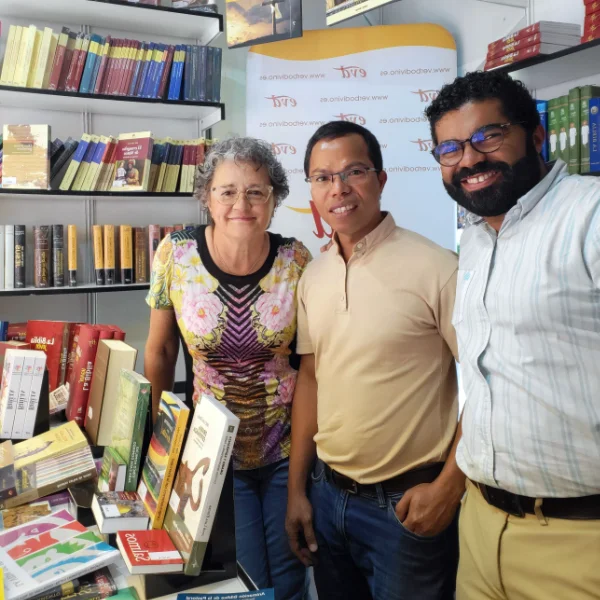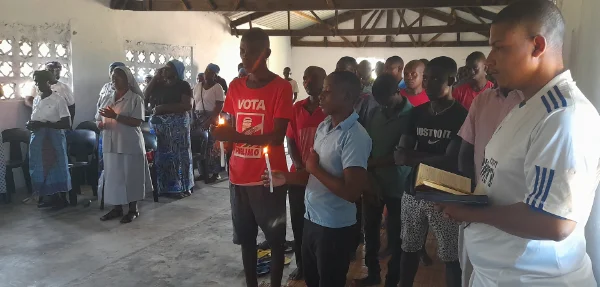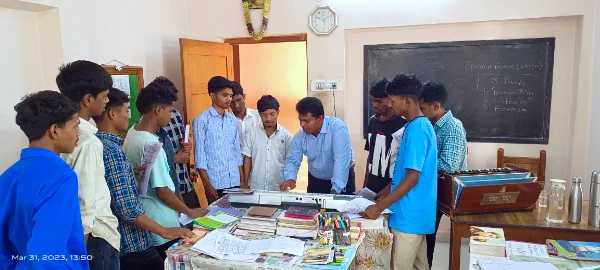- svd-generalate
- / Leadership /
- March 13, 2024
Embracing the Light: Exploring the Characteristic Dimensions of SVD Mission
Father Paulus Budi Kleden and the Leadership Team
 The General Chapter of the year 2000 recognized four characteristic dimensions of our missionary life and service: Bible apostolate, mission animation, justice, peace and integrity of creation, and communication. They constitute four identifying features of our life and mission and shape our missionary service, not as a monopoly of specialists but as a distinctive mark of every SVD in every stage of our life and whatever our apostolate. They also shape community life, for it is in a community that we seek to practice the Bible sharing, encourage each other for the mission, strive for peace and justice to reign among all, and relate fraternally to each other.
The General Chapter of the year 2000 recognized four characteristic dimensions of our missionary life and service: Bible apostolate, mission animation, justice, peace and integrity of creation, and communication. They constitute four identifying features of our life and mission and shape our missionary service, not as a monopoly of specialists but as a distinctive mark of every SVD in every stage of our life and whatever our apostolate. They also shape community life, for it is in a community that we seek to practice the Bible sharing, encourage each other for the mission, strive for peace and justice to reign among all, and relate fraternally to each other.
Each four characteristic dimension implies a basic attitude in our life and service. In Bible apostolate, the basic attitude is to live centered in God; in mission animation, it involves others, encouraging them with our enthusiasm on the path of the Kingdom and letting ourselves be encouraged by them. The basic attitude in JPIC is to commit ourselves to transforming society and the world through analyzing unjust structures, promoting human dignity, and preserving the environment instead of remaining silent in the face of tragedies and violence. Communication involves reaching out to others, especially our dialogue partners (cf. XVI General Chapter #9). In preparation for the upcoming General Chapter, the second guide for communal reflection includes some questions that can help us deepen our understanding of the four characteristic dimensions.
The Incarnate Word as the light of the world
 We appreciate the many activities our PRMs organize and promote Bible apostolate, from workshops and seminaries to publishing Bible-related books and materials. However, this apostolate needs to be connected to a personal and community life inspired by the Word of God; the Bible apostolate has an ad intra component to sustain communities transformed by the Word that nourishes, strengthens, and encourages.
We appreciate the many activities our PRMs organize and promote Bible apostolate, from workshops and seminaries to publishing Bible-related books and materials. However, this apostolate needs to be connected to a personal and community life inspired by the Word of God; the Bible apostolate has an ad intra component to sustain communities transformed by the Word that nourishes, strengthens, and encourages.
Those who dedicate their lives to the investigation of Sacred Scripture or the transmission of its message cannot remain indifferent to the object of their study and, prior to any Bible apostolate, should cultivate an attitude of listening to the Word of God. Constitution 106 states, “It is by listening to the word of God and living it that we become co-workers of the Divine Word.” In preparation for the next General Chapter, we are called to emphasize Arnold Janssen’s vision of the Incarnate Word as the light of the world and to deepen our relationship with the Divine Word.
Journeying together in mission
Mission animation is rooted in the conviction that the whole Church is missionary, and all Christians are called to participate in the mission of God. This fundamental idea, on which missionary animation is grounded, has consequences for our life and must produce specific changes in our mission, for example, moving from the desire to control others to teamwork and from personal protagonism to subsidiarity. It presupposes giving up clericalism and individualism in our life and apostolic service. It requires the creation of conditions that enable the laity to develop their talents and gifts to carry out their mission in the Church and the world.
We are grateful for the many activities organized by PRMs to raise mission awareness among the people, like mission festivals, prayer events, pilgrimages, formation programs for the laity, and so on. Also, in some PRMs, there is a good number of benefactors who, through their financial support and prayer, participate in our mission. Nevertheless, mission animation consists primarily of involving others without the temptation of wanting to control everything or thinking that we can do everything alone.
The wounded world as the locus of our healing mission
 A profound experience of God, the source of all compassion, is the force behind the actions in JPIC and an invitation to a permanent conversion of heart. Constitution 112 reminds us that “our faith calls us to recognize the presence of Christ in the poor and the oppressed,” adding that it is our duty “to promote justice according to the gospel in solidarity with the poor and the oppressed.” The dimension of JPIC goes behind concrete initiatives of assistance to solve problems, like famine, and alleviate suffering caused by war or natural disasters. It includes the struggle “against the sinfulness of the human heart, which is at the root of the oppressive structures and systems that cause these evils” (const 112.2).
A profound experience of God, the source of all compassion, is the force behind the actions in JPIC and an invitation to a permanent conversion of heart. Constitution 112 reminds us that “our faith calls us to recognize the presence of Christ in the poor and the oppressed,” adding that it is our duty “to promote justice according to the gospel in solidarity with the poor and the oppressed.” The dimension of JPIC goes behind concrete initiatives of assistance to solve problems, like famine, and alleviate suffering caused by war or natural disasters. It includes the struggle “against the sinfulness of the human heart, which is at the root of the oppressive structures and systems that cause these evils” (const 112.2).
Thus, JPIC proceeds prophetically in two directions that mutually enrich each other: the denunciation of evil and the commitment to constructing good. A mission anchored in the prophetic Word also requires the recognition of the dignity of every human being and the valuing of creation threatened by exploitation without limits. It also calls for continuous attention to the injustices in our own communities and the indifference to ecological awareness that sometimes occurs in individual and communal behavior. In preparation for the Chapter, we must focus “on promoting healing to restore the dignity of life and the integrity of social order.”
Communicating light is communicating life
 Several structures in the area of communication in our Society produce a wide range of activities and use a variety of means, for example, printing press, television, radio, websites, YouTube, social media, etc. But communication, as a characteristic dimension, is more than a set of tools and information technologies; it is also the art of promoting closeness and encounters with others. From a Christian perspective, the mystery of the Trinity is the origin and model of communication. For this reason, we are challenged to grow in communion with God and to seek to make ourselves and our communities an “expression of the communicative nature of God, which is community and communication” (SVD Characteristic Dimensions #68).
Several structures in the area of communication in our Society produce a wide range of activities and use a variety of means, for example, printing press, television, radio, websites, YouTube, social media, etc. But communication, as a characteristic dimension, is more than a set of tools and information technologies; it is also the art of promoting closeness and encounters with others. From a Christian perspective, the mystery of the Trinity is the origin and model of communication. For this reason, we are challenged to grow in communion with God and to seek to make ourselves and our communities an “expression of the communicative nature of God, which is community and communication” (SVD Characteristic Dimensions #68).
Like Jesus, the missionary does not spread a message but must share his life. This sharing requires an attitude of listening and conversion, placing one’s attention on the Other and others because “communication at its most profound level is the giving of self in love” (const. 115). In this way, we contribute to spreading the light of the Word that overcomes the darkness of the world and brings hope and joy to all children of God.
Addressing challenges to carry our mission
Our Society has appointed people and allocated resources to establish structures and ministries to cultivate and implement the four characteristic dimensions. Nevertheless, the Chapter can help us to address two challenges to carry on our mission as faithful and creative disciples. The first is to further promote closer collaboration between the four characteristic dimensions. As the present synod of the Church tells us, it is by journeying and working together that we build communion, promote participation, and engage in mission.
Another challenge is to deepen our understanding of dimensions as basic attitudes of our life, expressions of our religious-missionary identity, and not only specialized ministries done by experts. Thus, the characteristic dimensions can become creative instruments of the missionary service of every SVD and our mission partners.
Father Paulus Budi Kleden and the Leadership Team

